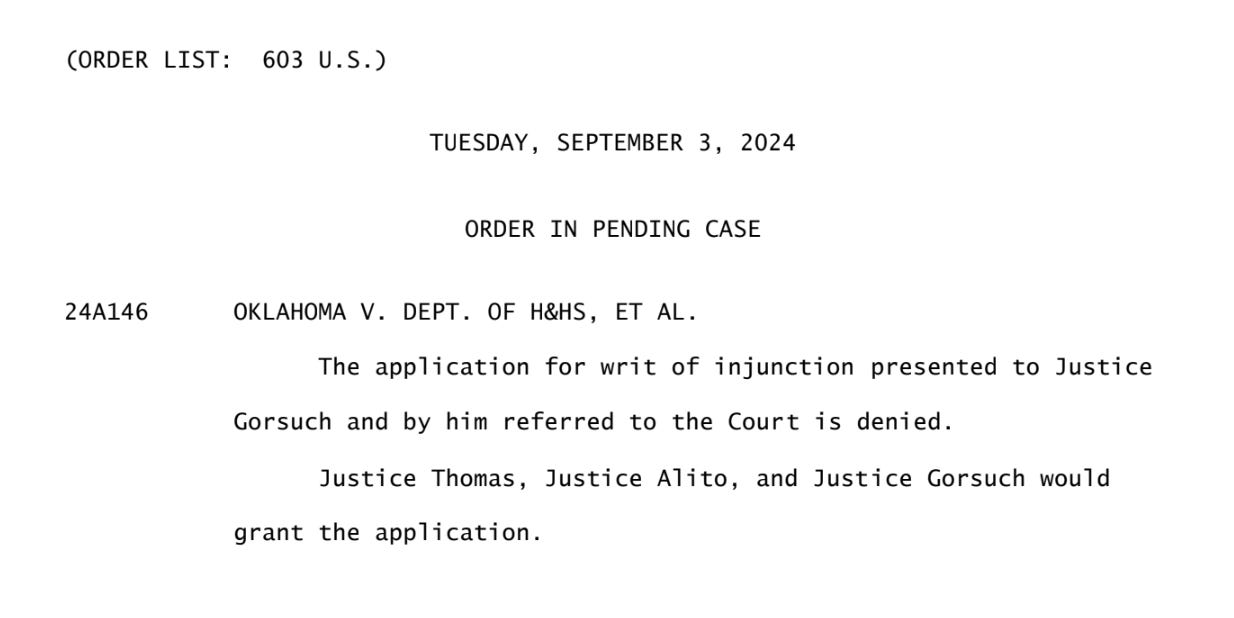Welcome to September at Law Dork, and thank you for being one of more than 36,000 people supporting Law Dork with a free subscription! I am so grateful. Journalism costs money, though, so please consider upgrading to a paid subscription now for as little at $6 a month. If you do that, you’ll receive bonus features available only to paid subscribers — and support this essential reporting. I know that not everyone can afford it or prioritize a paid subscription, and, if that’s you, I am so glad you are here! Thanks, Chris SCOTUS dodges post-Roe Title X family-planning funding grant questions — for nowThe two-sentence order was a reminder of an ongoing rift among the court's conservatives about how to handle legal challenges in the wake of Dobbs.On Tuesday, the U.S. Supreme Court kept out of an abortion-related dispute for the time being, rejecting Oklahoma’s shadow-docket request challenging the Department of Health and Human Services’s cancellation of the state’s Title X family-planning funding grants. The brief order, however, was a reminder of ongoing, stark disagreements among the court’s conservatives about how to handle litigation in the aftermath of the court’s 2022 decision ending the constitutional right to an abortion in Dobbs v. Jackson Women’s Health Organization. In the two-plus years since the Supreme Court overturned Roe v. Wade, the Biden administration’s HHS has been enforcing its Title X grant recipient requirements that include “nondirective counseling and referrals for all family-planning options, including abortion,” as one judge described it. When Oklahoma questioned the requirements in light of its post-Roe, near-total abortion ban, HHS offered that it would provide a national call-in number that Oklahoma could give to individuals. Oklahoma officials rejected the offer, HHS cut their grant, and Oklahoma sued. The state lost in both district court and, on a 2-1 vote, in the U.S. Court of Appeals for the Tenth Circuit, but then Oklahoma asked the Supreme Court to step in and issue an injunction barring HHS from canceling Oklahoma’s grant — a request covered at Law Dork previously. On Tuesday, the Supreme Court denied the request — but Justices Clarence Thomas, Sam Alito, and Neil Gorsuch noted that they would have granted the injunction. Due to this being a shadow-docket matter, we don’t know the other justices’ votes — only knowing that at least five of the six remaining justices rejected Oklahoma’s request. It seems likely to me, though, that this was a 6-3 vote, reminiscent of this June’s ruling from the court in the litigation over the potential conflict between Idaho’s near-total abortion ban and the Emergency Medical Treatment and Active Labor Act (EMTALA). In that ruling, Justice Amy Coney Barrett wrote, joined by Chief Justice John Roberts and Justice Brett Kavanaugh, that, in essence, the Supreme Court had acted too quickly to get involved there by taking the case before the appeals court was able to rule on the case. Given that Oklahoma’s request here was asking the court to effectively overrule a federal agency and two lower courts on the shadow docket, it would not be surprising to see those three join with the Democratic appointees in refusing to do so. At the same time, it’s almost more notable that — even after the debacle over the Supreme Court’s treatment of EMTALA case — Thomas, Alito, and Gorsuch were still all in and ready to block HHS this week. Given that this was on the shadow docket and the justices don’t need to announce their votes, moreover, the trio did more than that. They weren’t only ready to act; they wanted everyone outside the court to know it. Why that matters is two-fold. First, this let Oklahoma and the right to know that the trio voted with them. Sure, their vote might not be a surprise — this is the same trio that opposed the court’s move to de-escalate in the EMTALA litigation — but noting their vote publicly is a simple way for them to remind everyone on the anti-abortion right that they are their most stalwart backers. Second, and I think more importantly, Thomas, Alito, and Gorsuch let people on the right to know that they tried to act and were stopped. By noting their vote, they made clear it was a divided vote — and that they couldn’t get more than one of the other justices (and quite possibly, no other justice) to join them. Although that might not be the headline takeaway for most, I’m sure that’s what anti-abortion advocates — and close-watching abortion supporters — saw in Tuesday’s brief order. Now, the long-term consequences of this rift — or whether it will even remain a rift — aren’t yet clear. It’s entirely possibly that this is — for Roberts, Kavanaugh, and Barrett, at least — another example of the election-contingent moment that the court (and litigators, and, thus, all of us) are in right now. Or, it could be a longer-term issue. Regardless, it is something — and Thomas, Alito, and Gorsuch wanted us to know about it. Law Dork in the mediaParker Malloy asked me some questions about journalism and what the heck is going on! I answered them over at Depth Perception! Truly, it was a great opportunity to stop and think about what I’m doing here at Law Dork and why I love it so much. Check it out. You’re a free subscriber to Law Dork, with Chris Geidner. To further support this independent legal journalism, please consider becoming a paying subscriber. |

